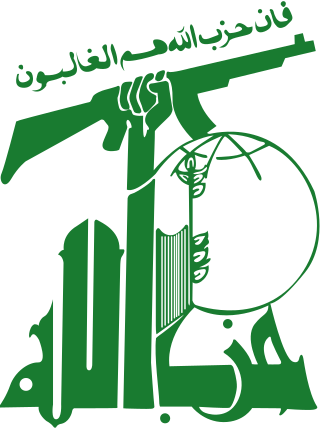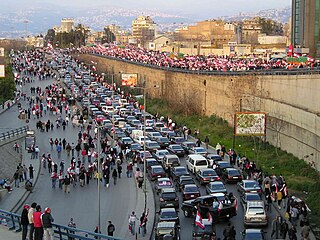Related Research Articles

Hezbollah is a Lebanese Shia Islamist political party and militant group, led by its Secretary-General Hassan Nasrallah since 1992. Hezbollah's paramilitary wing is the Jihad Council, and its political wing is the Loyalty to the Resistance Bloc party in the Lebanese Parliament.

The history of Lebanon covers the history of the modern Republic of Lebanon and the earlier emergence of Greater Lebanon under the French Mandate for Syria and the Lebanon, as well as the previous history of the region, covered by the modern state.

The 1982 Lebanon War, dubbed Operation Peace for Galilee by the Israeli government, later known in Israel as the Lebanon War or the First Lebanon War, and known in Lebanon as "the invasion", began on 6 June 1982, when the Israel Defense Forces (IDF) invaded southern Lebanon. The invasion followed a series of attacks and counter-attacks between the Palestine Liberation Organization (PLO) operating in southern Lebanon and the IDF that had caused civilian casualties on both sides of the border. The military operation was launched after gunmen from Abu Nidal's organization attempted to assassinate Shlomo Argov, Israel's ambassador to the United Kingdom. Israeli Prime Minister Menachem Begin blamed Abu Nidal's enemy, the PLO, for the incident, and used the incident as a casus belli for the invasion.

The Kataeb Party, also known in English as the Phalanges, is a Christian political party in Lebanon. The party played a major role in the Lebanese Civil War (1975–1990). In decline in the late 1980s and 1990s, the party slowly re-emerged in the early 2000s and is currently part of the March 14 Alliance. The party currently holds 4 out of the 128 seats in the Lebanese Parliament.

The Lebanese Civil War was a multifaceted armed conflict that took place from 1975 to 1990. It resulted in an estimated 120,000 fatalities and an exodus of almost one million people from Lebanon.
The Taif Agreement, officially known as the National Reconciliation Accord, was reached to provide "the basis for the ending of the civil war and the return to political normalcy in Lebanon". Negotiated in Taif, Saudi Arabia, it was designed to end the decades-long Lebanese Civil War, reassert Lebanese government authority in southern Lebanon, which was controlled at the time by the Christian-separatist South Lebanon Army under the occupational hegemony of Israel. Though the agreement set a time frame for withdrawal of Syrian military forces from Lebanon, stipulating that the Syrian occupation end within two years, Syria did not withdraw its forces from the country until 2005. It was signed on 22 October 1989 and ratified by the Lebanese parliament on 5 November 1989.

United Nations Security Council resolution 1559, adopted on 2 September 2004, after recalling resolutions 425 (1978), 426 (1978), 520 (1982) and 1553 (2004) on the situation in Lebanon, the Council supported free and fair presidential elections in Lebanon and called upon remaining foreign forces to withdraw from the country.

The Amal Movement is a Lebanese political party and former militia affiliated with the Shia community. Founded by Musa Al-Sadr and Hussein el Husseini in 1974, the party has been led by Nabih Berri since 1980.
The War of the Camps, was a subconflict within the 1984–1990 phase of the Lebanese Civil War, in which the Palestinian refugee camps in Beirut were besieged by the Shia Amal militia. The final weeks of fighting has been called War of the Flags.

The Lebanese Forces is a Lebanese Christian-based political party and former militia during the Lebanese Civil War. It currently holds 19 of the 128 seats in Lebanon's parliament and is therefore the largest party in parliament.

The Syrian occupation of Lebanon began in 1976, during the Lebanese Civil War, and ended on 30 April 2005 after the Cedar Revolution and several demonstrations in which most of the Lebanese people participated, and the withdrawal agreement was signed by President Bashar al-Assad and Saad Hariri, son of Rafic Hariri. All of these changes were a result from the assassination of former Lebanese Prime Minister Rafic Hariri.
The Israeli–Lebanese conflict, or the South Lebanon conflict, was a series of military clashes involving Israel, Lebanon and Syria, the Palestine Liberation Organization, as well as various militias acting from within Lebanon. The conflict peaked in the 1980s, during the Lebanese Civil War, and has abated since.

The South Lebanon conflict, designated by Israel as the Security Zone in Lebanon Campaign, was a protracted armed conflict that took place in southern Lebanon from 1985 to 2000. It saw fighting between the Christian-dominated South Lebanon Army (SLA) and Hezbollah-led Muslim guerrillas within the Israeli-occupied "Security Zone"; the SLA had military and logistical support from the Israel Defense Forces over the course of the conflict and operated under the jurisdiction of the Israeli-backed South Lebanon provisional administration, which succeeded the earlier Israeli-backed State of Free Lebanon. It can also refer to the continuation of the earlier conflict in this region that began with the Palestinian insurgency in southern Lebanon, which targeted Christian Lebanese factions and Israel following the expulsion of the Palestine Liberation Organization (PLO) from Jordan after Black September. Historical tensions between Palestinian refugees and Lebanese factions fomented the violent internal political struggle between the latter. In light of these factors, the South Lebanon conflict can be seen as a part of the Lebanese Civil War.
Hezbollah has a military branch and is the sponsor of a number of lesser-known groups, some of which may be little more than fronts for Hezbollah itself. These groups include the Organization of the Oppressed, the Revolutionary Justice Organization, the Organization of Right Against Wrong, and Followers of the Prophet Muhammad.
The Fathallah barracks were the early headquarters of the Hezbollah organisation, situated in the Basta neighbourhood of West Beirut. On 22 February 1987, following the defeat of the Amal Militia by a combination of Druze and Communist street fighters, 7,000 Syrian commandos moved into West Beirut for the first time since 1982. On 24 February the Basta HQ was taken over by the Syrians after an incident in which a Syrian soldier was wounded in the leg. At least 20 young Hizbollah supporters were taken prisoner and executed. Other sources put the number of victims as twenty seven, twenty three men and four women. Fifty thousand people attended their funeral. The killings put intense strain on the relationship between Iran and Syria and under pressure from Tehran the Syrian army stopped further activity in Beirut's Southern suburbs with its population of 800,000 Shiites. Hezbollah's headquarters were later moved to secret locations in Dahieh, a suburb of Beirut.

The Palestinian insurgency in South Lebanon was a conflict initiated by Palestinian militants based in South Lebanon upon Israel from 1968 and upon Christian Lebanese factions from the mid-1970s, which evolved into the wider Lebanese Civil War in 1975 and lasted until the expulsion of the Palestine Liberation Organization from Lebanon in the 1982 Lebanon War. Although the PFLP-GC and some other Palestinian factions continued low-level military activities on Lebanese soil, after 1982 the conflict is considered to have faded in favor of local inter-Lebanese Mountain War and the Israel–Hezbollah conflict.

The Lebanese Resistance Regiments, also designated Lebanese Resistance Battalions, Lebanese Resistance Detachments, Lebanese Resistance Legions and Battalions de la Resistance Libanaise (BRL) or Légions de la Resistance Libanaise (LRL) in French, but simply known by its Arabic acronym أَمَل ʾAmal which means "Hope", were the military wing of the Movement of the Dispossessed or Movement of the Deprived, a political organization representing the Muslim Shia community of Lebanon. The movement's political wing was officially founded in February 1973 from a previous organization bearing the same name and its military wing was formed in January 1975. The Amal militia was a major player in the Lebanese Civil War from 1975 to 1991. The militia has now been disarmed, though the movement itself, now known as the Amal Movement, is a notable Shia political party in Lebanon.

The Israeli occupation of Southern Lebanon formally began in 1985 and ended in 2000 as part of the South Lebanon conflict. In 1982, Israel invaded Lebanon in response to a spate of attacks carried out from Lebanese territory by Palestinian militants, triggering the 1982 Lebanon War. The Israel Defense Forces (IDF) and allied Christian Lebanese militias subsequently seized large parts of Lebanon, including the capital city of Beirut, amid the hostilities of the wider Lebanese Civil War. Israel later withdrew from most of the occupied territory between 1983 and 1985, but retained control over areas along the Israel–Lebanon border that would later comprise the Israeli "Security Zone" in coordination with the separatist State of Free Lebanon, which collapsed in 1984. From 1985 onwards, Israel supported the South Lebanon Army (SLA), the Lebanese Christian quasi-military of the collapsed Free Lebanon State, against Hezbollah and other Muslim militants in most of Southern Lebanon; Israel's overall stated purpose for the Security Zone was to create a buffer separating Israeli civilians in northern border towns from Lebanon-based terrorists. In 1993, it was estimated that there were 1,000–2,000 Israeli troops and 2,300 SLA troops active in the area.
Ahmad Al-Assir is a Lebanese former Sunni Imam of the Bilal Bin Rabah Mosque in Sidon, who became an ex-leader of an Islamist group, that attacked the Lebanese Army in 2013 in Saida. He is considered by some to be a Salafi.
References
![]() This article incorporates text from this source, which is in the public domain . Country Studies. Federal Research Division.
This article incorporates text from this source, which is in the public domain . Country Studies. Federal Research Division.
- ↑ "Lebanon Pax Syriana" . Retrieved 1 March 2007.
- ↑ "Back to the Brink with a Demi-Coup". Time Magazine. 22 March 1976. Archived from the original on 13 May 2007. Retrieved 22 May 2010.
- ↑ Veenhoven, Willem A., ed. (1976). "Case Studies on Human Rights and Fundamental Freedoms: A World Survey". III. The Hague: Foundation for the Study of Plural Societies.
{{cite journal}}: Cite journal requires|journal=(help) - ↑ Ghattas, Kim (24 March 2005). "The end of sectarianism in Lebanon?". Bitterlemons-international.org/. Archived from the original on 8 July 2017. Retrieved 2 March 2007.
- 1 2 3 4 5 The Library of Congress, Syria : A Country Study
- ↑ "Syriana: About the Film" . Retrieved 1 March 2007.
- ↑ Gaghan, Stephen (15 November 2005). "Movies: 'Syriana'". Online transcript. The Washington Post. Retrieved 2 March 2007.